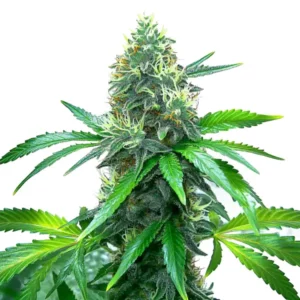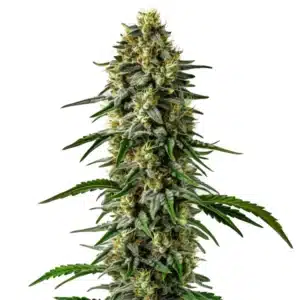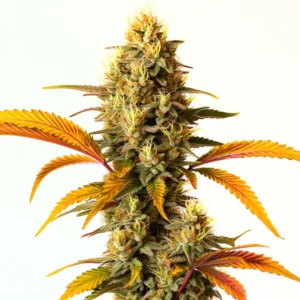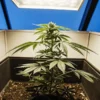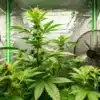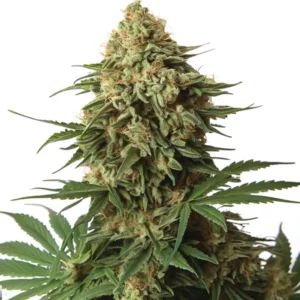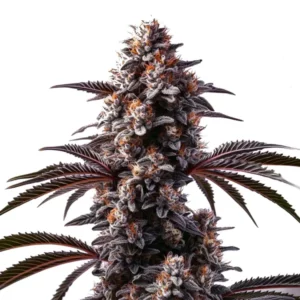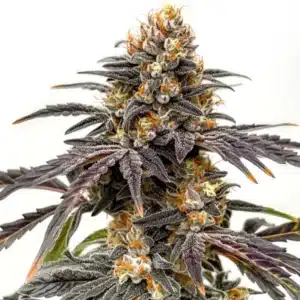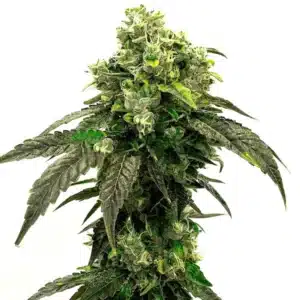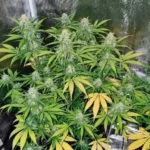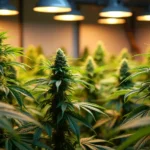
Light Signaling Pathways in Cannabis
Light signaling pathways in cannabis play a crucial role in the plant’s growth cycle. These pathways help the plant detect light, triggering various growth responses. For those new to growing cannabis, it’s important to understand how light affects your plants. Even experienced growers can benefit from a deeper dive into these pathways. By optimizing light conditions, you can significantly boost your yield and potency.
Photoreceptor pathways in cannabis plants are the internal mechanisms that allow plants to sense light. They act like the plant’s eyes, detecting changes in light quality, intensity, and duration. This detection impacts how and when a plant grows. Light signaling pathways in cannabis work through a set of proteins known as photoreceptors. These proteins influence growth by regulating gene expression, ensuring the plant makes the best use of available light.
Recommended Strains
OG Kush
|
|
THC | 20% - 24% (Medium) |
|
|
Type | Feminized |
|
|
Yield | Medium |
|
|
Phenotype | 55% Indica / 45% Sativa |
Blue Dream
|
|
THC | 17% - 24% (Medium) |
|
|
Type | Feminized |
|
|
Yield | High |
|
|
Phenotype | 50% Indica / 50% Sativa |
Cannabis growth light response pathways are not just about growth. They also impact flowering, dormancy, and even disease resistance. For example, the famous strain Blue Dream thrives under specific light conditions. By tweaking light levels, growers can enhance specific traits like flavor and cannabinoid content, tailoring the plant to their needs.
Photoreceptor Pathways in Cannabis Plants
Photoreceptor pathways in cannabis plants involve several types of photoreceptors. Each type detects different wavelengths of light. The most well-known photoreceptors are phytochromes, cryptochromes, and phototropins. Phytochromes respond to red and far-red light, crucial for growth and flowering. Cryptochromes and phototropins respond to blue light, impacting leaf expansion and stem elongation.
Knowing the function of photoreceptor pathways in cannabis plants can provide growers with insights into optimizing growth environments. By analyzing how these pathways interact with different light sources, cultivators can fine-tune their setups for maximum efficiency. This level of precision can help in ensuring that cannabis plants receive the optimal conditions for robust growth and development.
The manipulation of these photoreceptor pathways in cannabis plants is a key element in modern cultivation techniques. With advancements in lighting technology, growers can now simulate natural sunlight conditions with greater accuracy. This allows for more controlled environments where the effects of light can be measured and adjusted, offering a deeper knowing of how light signaling pathways in cannabis influence overall plant health.
Regulatory Networks in Cannabis Light Signaling
Regulatory networks in cannabis light signaling involve complex interactions between photoreceptors and genes. When photoreceptors detect light, they send signals to specific genes. This process is known as light-induced gene expression. It ensures the plant can adapt to its environment efficiently. If a cannabis plant receives too much or too little light, these networks adjust growth patterns accordingly.
These regulatory networks are a testament to the intricate balance required for optimal plant health. By knowing these interactions, growers can better manage their cultivation strategies. Whether it’s adjusting the duration of light exposure or altering the spectrum of light used, these networks provide a framework for making informed decisions that enhance growth.
Regulatory networks in cannabis light signaling are also crucial in breeding programs. By selecting strains that exhibit favorable responses to light, breeders can develop new varieties that are more resilient and better suited to specific growing conditions. This approach not only improves yield but also enhances the overall quality of the cannabis produced, making it a vital aspect of modern horticulture.
Promos & Deals
Practical Applications for Growers
For practical applications, growers should pay attention to the type of light used. LED lights are popular because they can be tailored to specific wavelengths that benefit cannabis growth. They allow precise control over light exposure, making them ideal for indoor setups. Adjusting light cycles can also simulate seasonal changes, triggering flowering or vegetative growth as needed.
Knowing cannabis light signaling mechanisms is essential for optimizing these practical applications. By delving into how different light sources affect growth, growers can experiment with various setups to find the most effective solutions. This experimentation can lead to the discovery of lighting configurations that significantly enhance the growth and potency of cannabis plants.
Furthermore, practical applications of light signaling pathways in cannabis extend beyond just lighting choices. These pathways offer insights into how environmental factors interact with plant biology. By integrating knowledge of cannabis growth light response pathways, cultivators can implement strategies that maximize the synergy between light and other growth factors, such as temperature and humidity.

Choosing the Right Strain
Choosing the right strain is crucial for leveraging light signaling pathways. Strains like Blue Dream and OG Kush have different light needs. While Blue Dream may require more light for optimal growth, OG Kush can perform well with less. Knowing these needs helps in selecting the right lighting setup.
When selecting a strain, growers should consider how different cannabis light-induced gene expression profiles may affect growth outcomes. Some strains may respond more favorably to certain light wavelengths, resulting in enhanced growth or increased cannabinoid production. This consideration is vital for achieving specific cultivation goals, whether it be higher yields, faster growth, or improved potency.
Choosing the right strain also involves knowing the specific environmental conditions each variety thrives in. By aligning strain selection with the regulatory networks in cannabis light signaling, growers can optimize their setups to match the natural preferences of their chosen strains. This alignment not only improves growth outcomes but also ensures a more sustainable and efficient cultivation process.
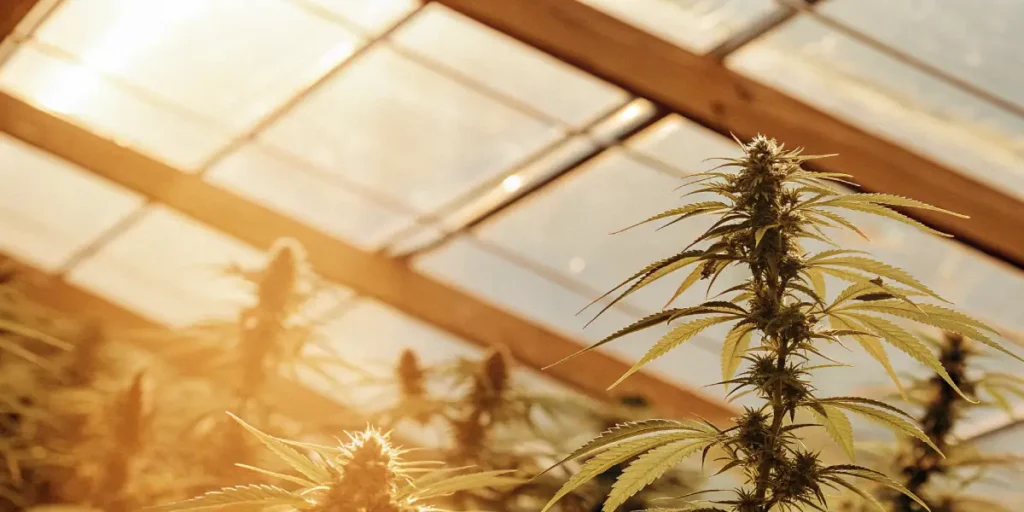
FAQs
What are light signaling pathways in cannabis?
Light signaling pathways in cannabis refer to the processes by which cannabis plants detect and respond to light. These pathways involve photoreceptors that sense light and trigger growth responses. By knowing these pathways, growers can optimize lighting conditions to improve plant health and yield.
These pathways are essential for various growth stages, including germination, vegetative growth, and flowering. They help the plant adapt to its environment by influencing how it grows and develops. Knowing how to manipulate these pathways can lead to more successful cultivation.
The study of light signaling pathways in cannabis is an evolving field, with ongoing research revealing new insights into how these mechanisms work. As our knowing grows, so too does the potential for more innovative cultivation techniques that harness these pathways to achieve superior results.
Incorporating knowledge of cannabis light signaling mechanisms into cultivation practices is not only beneficial for yield and potency but also for the sustainability of growing operations. By optimizing light use, growers can reduce energy consumption while maintaining high-quality outputs.
How do cannabis light signaling mechanisms affect growth?
Cannabis light signaling mechanisms impact growth by controlling how the plant responds to light. Different light wavelengths trigger specific growth responses. Red and blue lights are particularly important, affecting flowering and leaf expansion, respectively. Adjusting these light conditions can enhance plant growth and increase yields.
Light signaling mechanisms also play a role in stress management. They help the plant adapt to environmental changes, such as fluctuations in light intensity. By knowing and manipulating these mechanisms, growers can create optimal growing conditions for their plants.
The function of cannabis light signaling mechanisms in plant adaptation cannot be overstated. As environmental conditions change, these mechanisms allow plants to adjust their growth strategies, ensuring survival and productivity. This adaptability is a crucial component of successful cultivation.
By leveraging the insights gained from studying these mechanisms, growers can experiment with different lighting setups and schedules. This experimentation is key to discovering the most effective strategies for enhancing both the resilience and productivity of cannabis plants.
Can light type influence cannabis light-induced gene expression?
Yes, the type of light can significantly influence cannabis light-induced gene expression. Different photoreceptors in the plant respond to various light types, such as red or blue light. These responses trigger specific genes that control growth processes. By selecting the right light type, growers can influence gene expression to improve plant performance.
For instance, using LED lights with adjustable wavelengths allows growers to tailor light exposure to enhance certain traits. This control can lead to higher THC levels or bigger buds, depending on the grower’s goals. Knowing this relationship between light types and gene expression is key to successful cultivation.
The interaction between light type and cannabis light-induced gene expression is a dynamic area of study. By exploring how different light sources impact gene activity, researchers and growers alike can uncover new ways to optimize plant growth and development.
The ability to influence gene expression through light manipulation opens up new possibilities for targeted cultivation strategies. By aligning light conditions with desired growth outcomes, growers can enhance the effectiveness of their cultivation efforts, resulting in superior quality plants.
What are the benefits of knowing cannabis growth light response pathways?
Knowing cannabis growth light response pathways offers several benefits. It allows growers to optimize their lighting setup for better growth and yield. By manipulating light conditions, growers can control plant size, flowering time, and even cannabinoid levels. This knowledge leads to more efficient and productive cultivation.
Additionally, knowing these pathways can help manage environmental stresses. Plants that receive the right light conditions are often more resilient to changes in their environment. This adaptability can result in healthier plants and higher quality yields, making it a valuable tool for any grower.
Arming oneself with knowledge of cannabis growth light response pathways can also lead to cost savings. By optimizing light usage, growers can reduce their energy consumption while still achieving excellent results. This efficiency is particularly valuable in large-scale operations where resource management is critical.
Moreover, knowing these pathways can aid in the development of new cultivation technologies. As researchers continue to explore the intricacies of light responses, innovative tools and techniques are likely to emerge, further advancing the field of cannabis cultivation.
How do regulatory networks in cannabis light signaling influence cultivation?
Regulatory networks in cannabis light signaling influence cultivation by controlling how plants adapt to light conditions. These networks involve interactions between photoreceptors and genes that dictate growth behavior. By knowing these networks, growers can better manage plant development and optimize light exposure.
These networks play a crucial role in managing plant stress. By adjusting light conditions, growers can enhance plant resilience and improve overall health. This adaptability makes it easier to achieve desired growth outcomes, from increased yields to improved cannabinoid profiles.
The influence of regulatory networks in cannabis light signaling extends to the long-term sustainability of cultivation practices. By optimizing light conditions based on these networks, growers can maintain high levels of productivity while minimizing environmental impact.
As our knowing of these networks deepens, the potential for more precise and effective cultivation strategies increases. This knowledge empowers growers to make informed decisions that not only enhance current yields but also pave the way for future advancements in cannabis cultivation.


